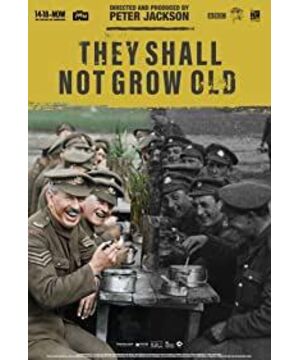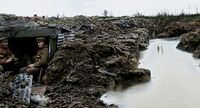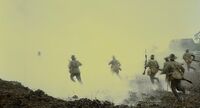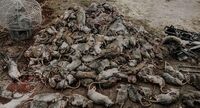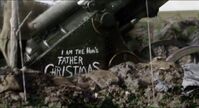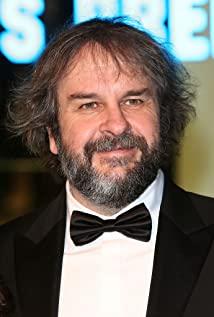The past November 11, 2018 was the centennial anniversary of the end of the First World War.
In this four-year war, nearly 10 million soldiers died on the battlefield.
In the Premier League in November, the players wore red poppies that symbolize anti-war to commemorate the young souls who died on the battlefield.
The director Peter Jackson, famous for his epic masterpiece [Lord of the Rings] series , also caught up with this anniversary and released this documentary on the soldiers of World War I [They are no longer getting old] .
They are no longer getting old. The melancholy and sad title of the film comes from a poem.
The British poet Lawrence Binion once wrote this famous line in "To the Fallen Soldiers":
They shall grow not old.
It is true that they will never grow old again. Those young boys have fixed themselves in that era forever, with only a few images left.
Fortunately, the director Peter Jackson completed this special documentary with extremely special patience and energy in the four years he spent.
To say that [they are no longer getting old] is special is not an exaggeration, but because it is almost subversive in documentary form .
Its pictures are all from those 100-year-old images that are sleeping in the museum, and its narration is all from the original soundtrack of interviews with veterans of World War I in the 1960s.
In terms of the authenticity pursued by the documentary and the restoration of history, I am afraid that no one will be more extreme than it.
At the beginning of the 20th century, photography technology had matured day by day. It took place during the First World War in the 1920s, and it actually left a lot of documentary images.
However, limited by the technology at the time, although there are not many images from 100 years ago, they are either intermittently incomplete, or full of noise, chemical stains and scratches.
This restoration work is a collaborative project led by the British Imperial War Museum and director Peter Jackson.
The director directly got more than 100 hours of old video materials handed over by the other party. In addition, he can use all the BBC's video and audio database.
There are only two requirements: only use these files and do it in an original way.
Although [they are no longer getting old] finally showed up for more than 90 minutes, but in fact, Jackson did an even more amazing job——
He repaired all the more than 100 hours of images he got.
The scratches, dust and stains accumulated over the decades were all cleaned up, and then these original materials were returned to the Imperial War Museum.
Not only that, there are other technical adjustments, such as changes to the number of frames.
You know, the old-fashioned hand-cranked cameras in the past only had 10 to 18 frames per second, while the normal images we see now are all 24 frames.
Therefore, the ancient silent films now look like Chaplin-style comedies deliberately slowed down. In order to change this, Jackson also adjusted the number of frames.
Of course, there is more intuitive, is to color the core part of the movie.
From the 25th minute and 20th second of the documentary, the young soldiers walked into the trenches with the young soldiers. The old black and white images were opened by the screen, and a clear and colorful trench world appeared in front of people.
Some people describe this as a wonderful moment like the "Wizard of Oz"——
Entering a new world with color allows the audience to face these people from a century ago in a more natural and intimate way.
As for the sound, the narration throughout the film comes from interviews with veterans retained for the documentary "World War I: The Great War" in the 1960s.
Jackson carefully selected the film’s story line from over 100 soldiers and 600 hours of interviews.
The work of selecting images and recordings alone took more than a year.
The sound effects other than the narration were reworked in the later stage, given that there was no sound reception technology at that time.
The team found a specialized lip language expert to identify those dialogues, and then dubbed them.
[They are no longer getting old] The pursuit of sophistication, it is not surprising that Jackson and the team took four years to complete.
The "Guardian" film critics said the final effect it achieved was "exciting":
The soldiers resumed a creepy life beyond reality before our eyes.
The "Daily Telegraph" commented that it is truly "unparalleled immediacy of historical portraits."
Jackson made it a real craftsmanship, pure and delicate, with the heart of a craftsman, thinking about the shadow of time.
On the Western Front during World War I, when the British and German armies were in a deadlock and were unable to move forward, the trenches became the most important battle between the two sides. It took four years for [they are no longer getting old]. The most commendable thing is not only its restoration project, but also that it directly aimed the lens at the young boys living in the trenches.
The history of war that we seem to be easier to read or see is often filled with important battles, progress in wars, or military technology and generals.
As for the real protagonists-countless live and ordinary soldiers, they are only recorded in the annals of history as statistics.
Jackson’s [they are no longer getting old] are different. The time and energy he spends is all for the young children. He pays attention to their trench experience, psychological feelings, all the excitement, fear, humanity and friendship, This is why the film is so moving.
So, you can hear how teenagers are altered in age and forced to enlist in the army. You can hear them from joining the army with innocent excitement at the beginning, to the real experience of life in the trenches, the little brilliance of their eyes is obliterated by nightmares.
In the documentary, all life in the trenches was painted with colors: green vegetation, dark green rivers, brown dead wood, dark green military uniforms.
Naturally, there will be yellow-green poisonous fog, brown-red plague, cannonballs raising white dust, and black-yellow trench feet (gangrene).
The restored colors are more corrupt and shocking.
The trenches are where they fight, rest, and live. In other words, they must be settled here when they eat, drink, and sleep.
But the trench is definitely not a very good "home", it is full of corruption.
The dead and the living live in it together, and the increasing number of corpses brings a rancid smell. One soldier described it as saying:
If you have smelled a dead mouse, it's much worse than that. You can't escape from that smell. It's everywhere, everywhere.
What followed were mice with chubby stomachs. They fed on corpses and swarmed around in groups while you were sleeping.
Not to mention lice, mites, scabies, and a large number of flies. When they are free, the soldiers grilling lice with fire has slowly become a recreational activity.
In addition, young soldiers not only died of bullets and poison gas, but also died of plague and gangrene caused by long standing water in the trenches.
Every winter or heavy rain, the stagnant water in the trenches becomes the most difficult challenge. Sometimes people are trapped in deep mud and drown, and some people are soaked in the water for a long time to produce terrible gangrene. Able to amputate.
Going to the toilet is more interesting.
They will dig a pit of more than one meter in length by the trenches, and planks will be placed on it to allow people to excrete in groups.
No privacy is the second thing. Going to the toilet takes a lot of risk, because the opponent’s artillery likes to throw a few shells on the board at this time. Some people may just fall into the pit and suffocate to death.
There are too many such hard, but sometimes interesting details in [They are no longer old]. Although the shadows of horror and death are everywhere, life in the trenches still has some unexpected flavors of life and laughter.
You can see them washing their faces, shaving, sitting around grilling lice together, sharing water in gasoline tanks, and using the heat of continuous high-speed shooting to make tea with water. An veteran even recalled:
It was an outdoor camping holiday with the boys, which made it interesting with a slight danger.
A precious and absurd joy on the gallows.
What the war is like, what are the ordinary soldiers who really participated in, [they are no longer getting old] in this sense is a truly unique epic masterpiece.
It doesn't care about war, it only cares about people who "no longer grow old", that's human.
From enlisting in the army with fist and fist, to being numb and numb, to becoming useless and nameless people in the post-war peace era, they deserve to be written.
-
Author/curl
This article was first published on the WeChat public account [Pocier]
View more about They Shall Not Grow Old reviews


